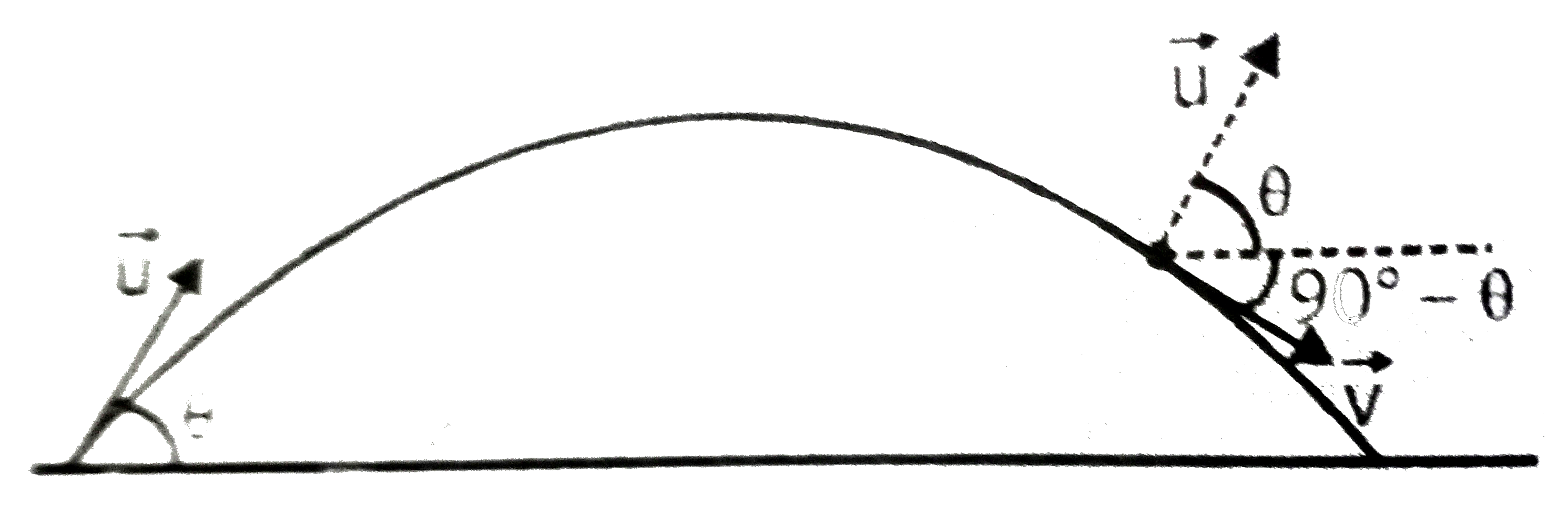A particle is projected with a velocity u making an angle θ with the horizontal. At any instant its velocity becomes v which is perpendicular to the initial velocity u. Then v is Solution in Gujrati
ucosθ
utanθ
ucotθ
usecθ
The correct Answer is:C

∵ horizontal component of velocity remains same
∴ucosθ=vcos(90−θ)
ucosθ=vsinθ⇒v=ucotθ
Topper's Solved these Questions
- BOOK - ALLEN CHAPTER - MOTION IN A PALNEEXERCISE - EXERCISE-341videos
MOTION IN A PALNE
- BOOK - ALLEN CHAPTER - MOTION IN A PALNEEXERCISE - SOLVED EXAMPLE28videos
MOTION IN A PALNE
- BOOK - ALLEN CHAPTER - MOTION IN A PALNEEXERCISE - EXERCISE-199videos
MOTION IN A PALNE
- BOOK - ALLEN CHAPTER - KINEMATICS-2DEXERCISE - Exercise (O-2)47videos
KINEMATICS-2D
- BOOK - ALLEN CHAPTER - NEWTON'S LAWS OF MOTION & FRICTIONEXERCISE - EXERCISE (JA)4videos
NEWTON'S LAWS OF MOTION & FRICTION
Similar Questions
Assertion : A body can have acceleration even if its velocity is zero at a given instant of time.
Reason : A body is momentarily at rest when it reverses its direction of motion.02:57View SolutionA particle thrown over a triangle from one end of a horizontal base falls on the other end of the base after grazing the vertex. If αandβ are the base angles of triangle and angle of projection is θ, then prove that (tanθ=tanα+tanβ)
05:37View SolutionThe distance x of a particle moving in one dimensions, under the action of a constant force is related to time t by the equation, t=√x+3, where x is in metres and t in seconds. Find the displacement of the particle when its velocity is zero.
02:01View SolutionA particle is moving in xy-plane .At certain instant the components of its velocity and acceleration are as follows ux=3m/s,uy=4m/s,ax=2m/s2anday=1m/s2. The rate of change of speed at this moment is
View SolutionA piece of wire is bent in the shape of a parabola y=kx2 (y-axis vertical) with a bead of mass m on it. The bead can slide on the wire without friction. It stays at the lowest point of the parabola when the wire is at rest. The wire is now accelerated parallel to the x-axis with a constant acceleration a. The distance of the new equilibrium position of the bead, where the bead can stay at rest with respect to the wire, from the y-axis is:
07:27View SolutionA particle is projected with velocity u at angle theta with horizontal. Find the time when velocity vector is perpendicular to initial velocity vector.
11:01View SolutionIn horizontal level ground to projectile if at any instant velocity becomes perpendicular to initial velocity then what can you say about projection angle with horizontal.
View SolutionA particle of mass m projected horizontally with velocity u . if it makes an angle theta with the horizontal after some time, then at that instant, its be Broglie wavelength is
View SolutionA particle is pojected from the ground at an angle of θ with the horizontal with an initial speed of u. Time after which velocity vector of the projectile is perpendicular to the initial velocity is
05:05View Solution" A body is projected with velocity u making an angle 30^(0) with the horizontal.Its velocity when it is perpendicular to the initial velocity vector is "
View SolutionA particle is projected with an initial velocity u, making an angle theta with the horizontal. Find the equation of the trajectory of the particle at any instant after the projection. Find expressions for the maximum height gained by the particle and its horizontal range.
View SolutionA particle is projected from the ground with velocity u making an angle theta with the horizontal. At half of its maximum heights,
View SolutionA particle is projected from the ground with velocity u making an angle theta with the horizontal. At half of its maximum heights,
View Solutionएक कण को क्षैतिज से θ कोण पर वेग (u) से प्रक्षेपित करते हैं। किसी क्षण इसका वेग (v) प्रारम्भिक वेग (u) के लम्बवत् है तो वेग v है
05:09View SolutionA particle is projected from the ground with velocity u making an angle θ with the horizontal. At half of its maximum heights,
View SolutionA particle is projected from the ground with velocity u making an angle θ with the horizontal. At half of its maximum heights,
05:56View Solution

